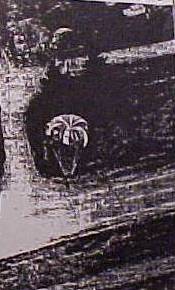|

For this flight, Smith and Bill had decided to jump at 7,500 feet. As the craft began to climb, Bill shouted above the noise, pointing to the tiers of white clouds, the blue sky and patches of farmland all framed in the open door.
"No matter how many times I see this," he said, "I cant get over how beautiful it is!"
Smith sat on the floor next to the open door for this flight because he was jumpmaster for the dive, meaning that he directed the pilot into position over the landing target.
At 2,500 feet, over the target, he leaned out the door and dropped a 10-inch by 20-foot yellow crepe paper streamer with a 3-ounce weight, a wind drift indicator, and watched it fall to earth. He explained that the apparatus was suppose to fall in the same way that a man in a parachute would. If the indicator had landed a mile north of the target, then the jumpmaster would direct the pilot a mile south of the target so that the jumpers could land in the target area.
At 7,500 feet, the temperature in the cockpit had dropped to 21 degrees centigrade. Smith shouted final corrections to Campbell.
"Two degrees south, one more degree west," he called, "O.K., cut your engine."
Campbell throttled down and Smith, followed quickly by Bill, climbed out onto the wing strut. Bill explained later that if the engine were not throttled, the force of the propeller would blow the jumpers off the wing.
Bill jumped first, followed a few seconds later by Smith. Both rapidly fell away from the plane. Their bodies, face downward, were parallel with the earth, arms and legs outstretched, backs arched.
They soared earthward in free-fall positions for 4,700 feet, before opening their colored chutes. The free fall lasted about 25 seconds while the parachute landing took about two minutes. Both divers had been blown about 300 yards north of the target.
The plane that had dropped them was still circling for a landing as the two walked back across the field to the airport, grinning and carrying their rolled-up chutes.
The club has about 10 student jumpers who are receiving instruction from Smith and Bill. Several of them, including a 17-year-old boy and a 26-year-old husband and father, listened with undisguised envy as Smith and Bill described their completed dives. The two students were to have made their first jumps last Sunday but windy weather had prevented it.
Payne said each student had to make at least five static line jumps (the chute automatically opens on leaving the plane) before they begin practicing free falls.
The students first free fall will begin when he simply jumps from the plane and pulls the rip cord. As the student masters free fall he will jump from higher altitudes and free-fall for longer periods of time.
Payne said the club provided the chute and equipment for students. A first jump will cost $47.50, he said, which will include $35 to join the club, $10 to join the USPA, and $2.50 for the jump.
Regular club members pay monthly dues of $5 and $2.50 for each jump they make. Payne estimated the average cost of equipment for a skydiver would be about $100.
He said the club, from about 11 to 6 oclock each Saturday and Sunday, would perform free skydiving exhibitions for spectators who would like to come to the airport to watch. Persons interested in joining the club can contact Payne.
|



